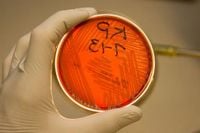On September 24, 2025, the Centers for Disease Control and Prevention (CDC) issued a stark warning: the United States is facing a dramatic surge in infections caused by a formidable drug-resistant bacteria known as NDM-CRE. As the CDC explained in its latest report published in the Annals of Internal Medicine, this rise is not just a blip on the radar—it’s a fivefold increase in cases over just four years, and the consequences could be deadly for thousands of Americans.
NDM-CRE, shorthand for NDM-producing carbapenem-resistant Enterobacterales, is a type of bacteria that has developed resistance to nearly all antibiotics, including carbapenems, which are considered a last line of defense in hospitals. The culprit behind this resistance? An enzyme called New Delhi metallo-beta-lactamase, or NDM for short. According to the CDC, this enzyme renders the bacteria nearly untreatable, making infections extremely difficult to control.
The numbers paint a sobering picture. In 2020, there were about 12,700 infections and 1,100 deaths in the U.S. attributed to CRE, the broader family of bacteria to which NDM-CRE belongs. But between 2019 and 2023, NDM-CRE infections alone shot up by more than 460 percent, the CDC reported. That means what was once a rare and exotic threat—often seen only in patients who had received medical care overseas—has now become a growing menace on American soil.
These infections can take many forms, including urinary tract infections, pneumonia, bloodstream infections, and wound infections. And they are not just hard to treat—they can be deadly. As Danielle Rankin, an epidemiologist in the CDC’s Division of Healthcare Quality Promotion, put it in a statement cited by The Hill and Fox News, “This sharp rise in NDM-CRE means we face a growing threat that limits our ability to treat some of the most serious bacterial infections. Selecting the right treatment has never been more complicated, so it is vitally important that healthcare providers have access to testing to help them select the proper targeted therapies.”
But testing is part of the problem. Many clinical laboratories across the country lack the capacity to detect NDM-CRE, meaning infections can go misdiagnosed or overlooked altogether. This is especially concerning because the bacteria can spread quickly in hospitals, nursing homes, and even in the broader community. According to the CDC, “consistent infection control practices—such as hand hygiene, wearing gloves and gowns during patient care, and proper cleaning and disinfection—help to prevent bacteria like NDM-CRE from spreading in healthcare settings.”
Still, the CDC admits that the true scale of the problem is likely even greater than current figures suggest. As LiveNOW from FOX and the Associated Press reported, the CDC’s data comes from just 29 states that have the necessary testing and reporting infrastructure. Some of the country’s most populous states—California, Florida, New York, and Texas—are missing from the dataset, meaning many cases are probably flying under the radar. “The CDC researchers did not have data from some of the most populous states... which means the absolute number of U.S. infections is definitely underestimated,” the Associated Press noted.
Why is this happening now? Experts point to several factors. Dr. Marc Siegel, a senior medical analyst for Fox News, called the trend “very concerning” and pointed to the overuse of antibiotics as a prime culprit. “It’s partly due to overuse of antibiotics, and part of a worldwide trend that breeds more and more resistance,” he told Fox News Digital. Dr. Jason Burnham of Washington University, who was not involved in the CDC study, added that the surge in antibiotic use during the COVID-19 pandemic likely played a role in accelerating resistance. Unfinished or unnecessary prescriptions provided bacteria with more opportunities to adapt and survive, making them stronger in the process.
When it comes to treatment, the options are slim and costly. Only two antibiotics—both expensive and requiring intravenous administration—are effective against many NDM-CRE infections, researchers told LiveNOW from FOX. Dr. Siegel listed novel antibiotics like ceftazidime-avibactam, meropenem-vaborbactam, plazomicin, and eravacycline as possible options, but he warned that “we don’t have enough antibiotics to treat it because it isn’t profitable enough to make them.” This shortage of effective drugs leaves patients, especially those with compromised immune systems, at higher risk of severe illness or death.
David Perlin, Ph.D., chief scientific officer at the Hackensack Meridian Center for Discovery and Innovation, underscored the urgency of better surveillance and testing. “This is one of the many drug resistance concerns right now for Americans—especially since we are seeing that surveillance is not keeping up with the evolution of the pathogens,” he told Fox News Digital. He urged healthcare providers to “do better to provide testing closer to the point of care, especially in emergency departments, so these infections can be identified rapidly for effective treatment and infection control.”
There are also broader public health implications. The CDC warned that as NDM-CRE becomes more common, infections that were once routine—like urinary tract infections—could become much harder to treat. Dr. Maroya Walters, one of the CDC report’s authors, cautioned that many people may be unrecognized carriers of the drug-resistant bacteria, potentially leading to community spread. “It’s likely many people are unrecognized carriers of the drug-resistant bacteria, which could lead to community spread,” the CDC scientists said, as quoted by LiveNOW from FOX.
So what can be done? Infection control remains critical. The CDC advises healthcare settings to maintain rigorous hand hygiene, use gloves and gowns when caring for patients, and ensure proper cleaning and disinfection of facilities. Early diagnosis is key, particularly for immunocompromised patients who are most vulnerable to rapid spread. Patients, for their part, are encouraged to be persistent if they have nagging infections and to advocate for thorough testing, especially if initial treatments are not working.
Despite these efforts, the road ahead looks challenging. The CDC has not pinpointed a single cause for the surge but cites gaps in infection control and limited testing as major contributors. With the bacteria’s ability to adapt and spread, and with so few effective treatments available, the U.S. is grappling with a public health threat that demands urgent attention from hospitals, policymakers, and the public alike.
As the CDC’s Danielle Rankin summed up, “The rise of NDMs in the U.S. is a grave danger and very worrisome.” With infections rising rapidly and antibiotic options dwindling, the nation faces a critical test in the ongoing battle against drug-resistant bacteria.





